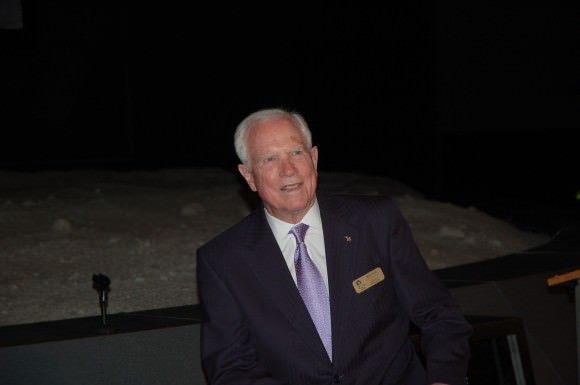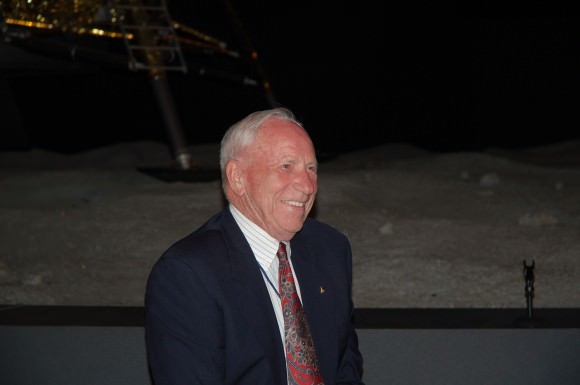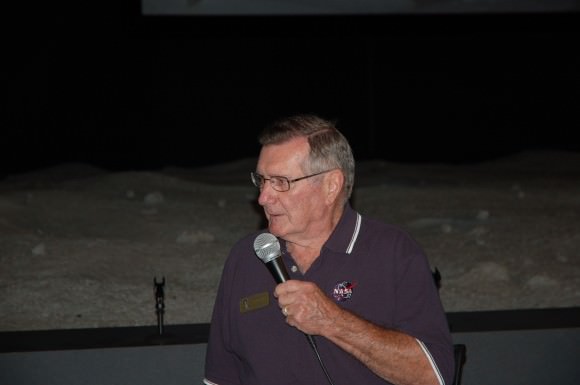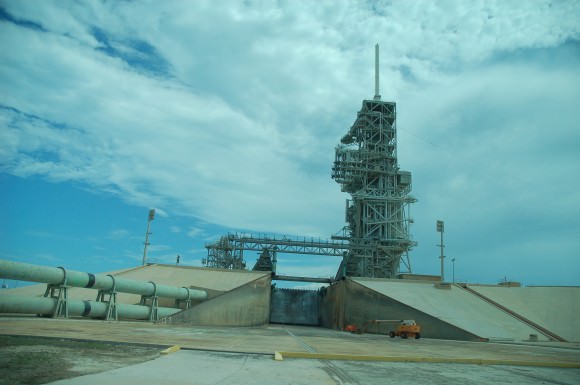[/caption]
CAPE CANAVERAL Fla. – Apollo 15 was the first manned lunar mission to use a lunar rover, the first of the “J” missions that would stay on the lunar surface longer and be focused on conducting science. Apollo 15 marked its 40th anniversary on Sunday. Most of the crew as well as other Apollo-era astronauts were present at the Kennedy Space Center Visitor Complex to mark the occasion.
The day’s events include a tour of the launch site at the adjacent Cape Canaveral Air Force Station. Shortly after returning to the Visitor Complex a panel discussion was held with Apollo 15 astronauts Dave Scott and Al Worden. The “moderator” for the event was none other than Apollo 12 Command Module Pilot Dick Gordon.

One thing that became quickly obvious was that the trio had done this before and were very comfortable with one another, clowning around, giving each other a hard time and telling jokes. Meanwhile, Gordon asked the two surviving Apollo 15 astronauts (the third member of the crew, James Irwin passed away in 1991) questions regarding the mission. This made learning about the importance of the mission both informative and fun. Panel discussions can be rather dry affairs – this one was lively and entertaining.
“I’ve lost control…” bemoaned Gordon as Scott and Worden talked about the mission to one another and the assembled guests.
At one point Worden was asked what the mission in general and his extra vehicular activity (EVA) was like.
“You know it’s like learning to play the piano, you practice and practice and practice and practice all week long and on Saturday you might give a recital,” Worden said. “But when the recital happens you don’t think about it – you just do it, there’s really not an emotional component to that.”

The operators of the Kennedy Space Center Visitor Complex spared little expense in ensuring that guests had a full and exciting day. The tour drove past several launch complexes including Launch Complex 34 (where the Apollo 1 fire occurred) as well as Launch Complex 39A, where the final shuttle mission launched from not too long ago. Each of the buses had the normal guide from the Visitor Complex as well as an Apollo-era astronaut, who regaled guests with various aspects of past missions. Guests also received a gift bag with several items enclosed to commemorate the occasion.
Apollo 15 launched on July 26, 1971 and ended with the splash down of the crew on Aug. 7, 1971. Scott and Irwin spent a total of three days on the moon with a little over 18 hours of that time spent on extra vehicular activity (EVA). Apollo 15 was also the first mission to not land on a lunar mare, but rather it landed near Hadley Rille, which is located around the area called Palus Putredinus (Marsh of Decay).

Having the lunar rover on this mission gave the moonwalkers the ability to traverse a far greater distance than what was possible on prior Apollo flights. While on the moon the duo collected about 170 lbs of rocks and lunar regolith. While Scott and Irwin were on the moon, Worden, circling high above in the Command Module compiled a highly detailed map of the lunar surface. A satellite was also deployed into lunar orbit on this mission (an Apollo first).
The day’s tour and panel discussion were capped off by a gala hosted by the Astronaut Scholarship Foundation. Those in attendance included Neil Armstrong as well as former Senator (New Mexico) and the first geologist to go to the moon Harrison ‘Jack’ Schmitt. Numerous other luminaries in the space field were present as well.



Apollo 15 was the first of the three “J” missions designed to conduct exploration of the Moon over longer periods, over greater ranges, and with more instruments for scientific data acquisition than on previous Apollo missions. Major modifications and augmentations to the basic Apollo hardware were made. The most significant change was the installation of a scientific instrument module in one of the service module bays for scientific investigations from lunar orbit.
Read here about second largest asteroid in the solar system – Vesta: http://www.facebook.com/notes/the-science-news/closer-look-to-the-goddess-of-fire/216976091681514
Apollo 15 was the first of the three “J” missions designed to conduct exploration of the Moon over longer periods, over greater ranges, and with more instruments for scientific data acquisition than on previous Apollo missions. Major modifications and augmentations to the basic Apollo hardware were made. The most significant change was the installation of a scientific instrument module in one of the service module bays for scientific investigations from lunar orbit.
Read here about second largest asteroid in the solar system – Vesta: http://www.facebook.com/notes/the-science-news/closer-look-to-the-goddess-of-fire/216976091681514
What surprised me about the moonlandings was how short they actually stayed at the moon.
One would expect that they would stay there a week or 2 after it took so much effort to get there.
Yo Jason, the Moon is a proper noun; therefore, it should be capitalized.
Yo IVAN3MAN_AT_LARGE – The Associated Press Style Book – moon – lowercase. Journalism 101 – it should NOT be capitalized.
Yo Jason, I refer you to the International Astronomical Union’s Naming of Astronomical Objects – Spelling of Names:
So there!